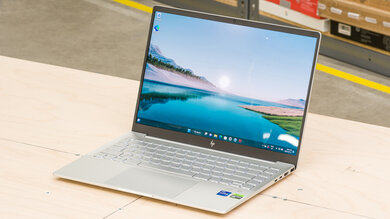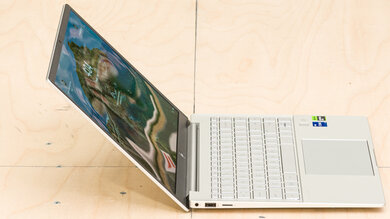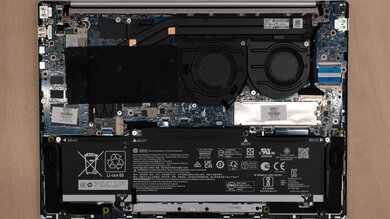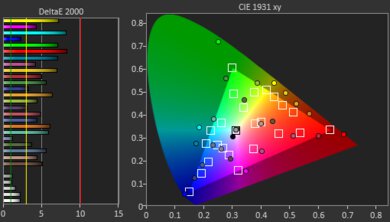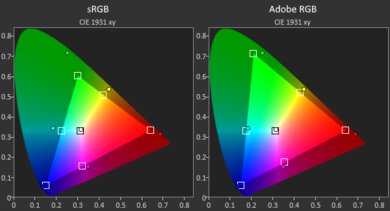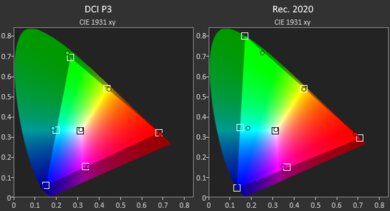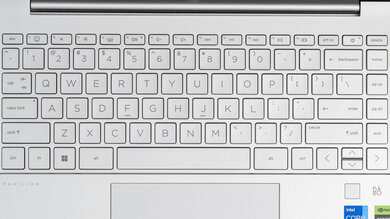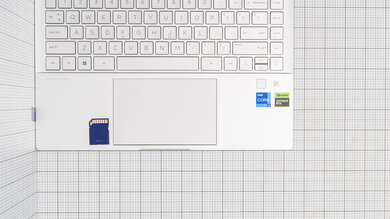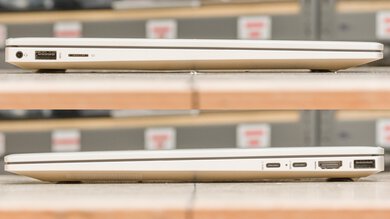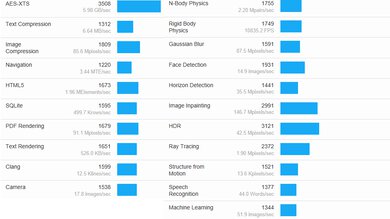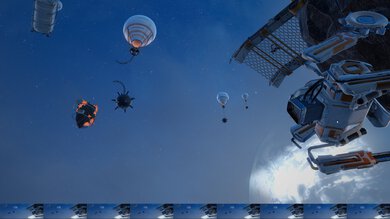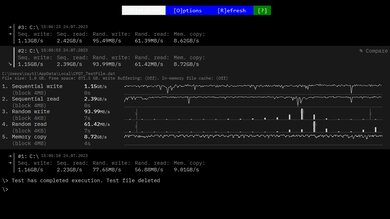The HP Pavilion Plus 14 (2023) is a mid-range Windows ultraportable laptop. It's available with various Intel 13th Gen CPUs, including U-, P-, and H-series processors. In addition to integrated Intel Iris Xe graphics, you can also get the laptop with an NVIDIA GeForce MX550 or RTX 2050 discrete GPU. Memory and storage max out at 16GB and 1TB, respectively. For the display, you can choose between a 2.2k (2240 x 1400) IPS and a 2.8k (2880 x 1800) 90Hz OLED panel. It has Wi-Fi 6E wireless connectivity, a fingerprint sensor, and a 51Wh battery. Ports include two USB-As, two USB-Cs, an HDMI, a MicroSD card reader, and a headphone jack. Only models with a Core i5-1340P or an H-series CPU have Thunderbolt 4 support.
You can see our unit's specifications and the available configuration options in the Differences Between Variants section.
Our Verdict
The HP Pavilion Plus 14 is decent for school use. It has a sturdy all-aluminum build and is very portable due to its compact and lightweight design. There are many CPU configuration options, including powerful Intel 13th Gen H-series CPUs, and you can also get the laptop with an NVIDIA discrete GPU, which is great for students in fields like 3D graphic design and animation. It has a sharp display, a spacious keyboard, a large touchpad, and a wide port selection. Unfortunately, its battery lasts only five to six hours of light use, so you'll have to plug it in at some point to get through a typical school day.
- Thin and lightweight.
- Sharp, bright display.
- Available with more powerful P- and H-series CPUs.
- RTX 2050 discrete GPU can handle moderately demanding workloads.
- Good keyboard and touchpad.
- Short battery lfe.
- OLED susceptible to permanent burn-in.
- No Thunderbolt 4 on models with U-series CPU.
The HP Pavilion Plus 14 is decent for gaming. You can get the laptop with an NVIDIA GeForce RTX 2050 discrete GPU, which is capable of pushing near 60 fps in demanding games, albeit with low graphical settings. It also has a 90Hz OLED display with a relatively fast response time for smoother motion and better responsiveness. It doesn't support VRR to reduce screen tearing, though. Thermal throttling is minimal, and the laptop doesn't get overly hot or loud under load. Unfortunately, you can only get up to 16GB of RAM, and the memory isn't user-replaceable.
- Available with more powerful P- and H-series CPUs.
- RTX 2050 discrete GPU can handle moderately demanding workloads.
- 90Hz OLED display with fast response time.
- Minimal CPU and GPU throttling under load.
- OLED susceptible to permanent burn-in.
- No VRR to reduce screen tearing.
- Soldered RAM.
The HP Pavilion Plus 14 is good for media consumption. Thanks to its thin and light design, it's very easy to carry around. You can get the laptop with a nice OLED display; it produces deep, inky blacks, which is great for dark rooms, and its full DCI P3 coverage makes it suitable for viewing HDR content. The speakers get very loud and sound clear, but like most laptop speakers, they have very little bass. Battery life is middling; you can get around five hours of video playback, which isn't terrible but not great.
- Thin and lightweight.
- Sharp, bright display.
- OLED display has full DCI P3 coverage.
- Loud speakers.
- Short battery lfe.
- OLED susceptible to permanent burn-in.
- Speakers lack bass and treble.
The HP Pavilion Plus 14 is great for use as a workstation. You can configure this laptop with a powerful Intel 13th Gen H-series CPU, and if you need more graphical processing power, it's also available with an NVIDIA GeForce RTX 2050 discrete GPU. It has a spacious keyboard, a wide port selection, and a fast, user-replaceable SSD. Its performance over time is excellent, and it doesn't get overly hot or loud under load. The main drawback is that you can only get up to 16GB of soldered RAM.
- OLED display has full DCI P3 coverage.
- Available with more powerful P- and H-series CPUs.
- RTX 2050 discrete GPU can handle moderately demanding workloads.
- Good keyboard and touchpad.
- Minimal CPU and GPU throttling under load.
- OLED susceptible to permanent burn-in.
- No Thunderbolt 4 on models with U-series CPU.
- Soldered RAM.
The HP Pavilion Plus 14 is good for business use. It has a sturdy build and is easy to carry around, thanks to its thin and light design. It's available with various Intel 13th Gen CPUs, all powerful enough to handle productivity tasks like text processing, spreadsheets, presentations, and video playback. It has a sharp display, a spacious keyboard, a large and responsive touchpad, an excellent 1440p webcam, and a wide port selection. The main drawback is its short battery life, lasting only five to six hours of light use.
- Thin and lightweight.
- Sharp, bright display.
- Excellent 1440p webcam.
- Good keyboard and touchpad.
- Short battery lfe.
- OLED susceptible to permanent burn-in.
- No Thunderbolt 4 on models with U-series CPU.
Changelog
-
Updated Nov 21, 2024:
Added the Lenovo Yoga 7 2-in-1 14 (2024) as an alternative with better build quality in the Build Quality section.
- Updated Jul 25, 2024: Added mention of the HP Pavilion Aero 13 (2024) as a more compact alternative in the Portability section.
- Updated Dec 18, 2023: We've corrected an error in the Portability section. The laptop weighs 3.2 lbs (1.4 kg), not 3.7 lbs (1.7 kg).
- Updated Dec 12, 2023: Added mention of the MSI Summit E16 Flip Evo (2023) as an alternative with faster NVIDIA 40-series GPUs in the GPU section.
Check Price
Differences Between Sizes And Variants
We tested the HP Pavilion Plus 14 (model 14-eh1299nr) with an Intel Core i7-1355U CPU, an NVIDIA GeForce RTX 2050 GPU, 16GB of RAM, and 1TB of storage. The CPU, GPU, memory, and storage are configurable; the available options are in the table below.
| Screen |
|
|---|---|
| CPU |
|
| GPU |
|
| Memory |
|
| Storage |
|
| Color |
|
You can see our unit's label here.
Popular Laptop Comparisons
The HP Pavilion Plus 14 is a good laptop overall. It has many configuration options, including powerful H-series CPUs and discrete GPUs, making it suitable for a wide range of uses. It also has a sturdy build and provides a good user experience with a sharp display, a spacious keyboard, and a responsive touchpad. However, its battery life is very short compared to other laptops in its class.
For more options, check out our recommendations for the best workstation laptops, the best laptops for graphic design, and the best laptops for photo editing.
The ASUS Zenbook 14 Flip OLED (2023) is much better than the HP Pavilion Plus 14 (2023). The ASUS is more versatile, as it's a 2-in-1 convertible with stylus support. It also has a sturdier build and provides a better user experience with a more tactile keyboard, a larger and more responsive touchpad, and longer battery life. On the other hand, the HP laptop has more configuration options, including more powerful H-series CPUs and discrete NVIDIA GPUs.
The LG gram 14 (2023) is better for general productivity, while the HP Pavilion Plus 14 (2023) is better if you have a slightly more CPU- or GPU-intensive workload. The LG is thinner and lighter, making it easier to carry around, and its battery lasts almost twice as long as the HP's. Additionally, it has a more comfortable keyboard and a smaller but more responsive touchpad. On the flip side, the HP is available with a much nicer OLED display, more powerful Intel H-series CPUs, and discrete NVIDIA GPUs. It also doesn't throttle as much under load.
The HP Pavilion Plus 14 (2023) is better than the Lenovo IdeaPad Flex 5i 14 (2022) for most uses. The HP is available with newer and faster CPUs, NVIDIA discrete GPUs, and sharper, brighter displays, including a 2.8k OLED panel with full DCI P3 coverage. It also has a much better 1440p webcam and doesn't throttle as much as the Lenovo under load. However, the Lenovo is more versatile since it's a 2-in-1 convertible, meaning you can flip the screen around and use it as a tablet, and its battery lasts much longer.
The HP Pavilion Plus 14 (2023) and the Acer Swift 14 (2023) are both good 14-inch Windows laptops. The HP has a better keyboard and touchpad, and it's available with NVIDIA discrete GPUs for more graphically intensive workloads. Its OLED display provides a better viewing experience due to its superb contrast ratio, and while it doesn't get as bright as the Acer laptop's display, it does have better reflection handling. However, the Acer is much lighter, making it more portable, and its battery lasts much longer.
Test Results

The HP Pavilion Plus 14 has a simple design with relatively thin bezels, a wedge-shaped chassis, and a silver-color finish. On the bottom, you'll find the speakers near the front and air vents near the back. There are also air vents at the back of the keyboard deck. If you prefer a 2-in-1 convertible laptop, check out the HP Spectre x360 14 (2023).
The HP Pavilion Plus 14's build quality is good. The chassis is aluminum, with a finish that doesn't easily scratch or pick up fingerprints. The lid and display flex a fair amount, but not the keyboard deck. There's no problem with the feet; they feel solid and stick firmly to the bottom of the laptop. The weight isn't evenly balanced, as it's a little front-heavy, but it's pretty minor and doesn't affect the overall user experience. If you want an alternative with better build quality, check out the Lenovo Yoga 7 2-in-1 14 (2024).
The HP Pavilion Plus 14 and its power adapter are compact and lightweight. Consider the HP Pavilion Aero 13 (2024) if you want a more compact HP laptop.
The HP Pavilion Plus' serviceability is okay. Accessing the internals is very easy; you only need to remove four Philips screws and undo the clips holding the bottom panel. A prying tool isn't necessary if you have strong nails. The screws are of two different sizes, so make sure you put them back in the right place. Unfortunately, the RAM isn't user-replaceable. You can see the maintenance and service guide here.
The HP Pavilion Plus 14 is available with the following displays:
- 14" IPS 2240 x 1400 60Hz
- 14" OLED 2880 x 1800 90Hz
The 2.8k OLED display looks very sharp and provides just enough space for split-screen multitasking. The 2.2k IPS panel isn't as sharp (189 PPI); however, the difference isn't noticeable at this screen size and at normal viewing distances. The 16:10 aspect ratio gives you slightly more vertical space than a standard 16:9 display, which is great for productivity, as the extra space lets you see more information when reading a document or website without having to scroll. The OLED panel is susceptible to permanent burn-in, especially with static elements like Windows' taskbar, but it's unlikely to be an issue for those viewing varied content.
While the OLED display's 90Hz refresh rate isn't particularly fast, it's great for a productivity laptop, as it makes the system feel more responsive than a standard 60Hz display without overly taxing the battery. Its response time is good but not as fast as higher-end OLED panels, which typically have a near-instantaneous response time. The IPS panel has a 60Hz refresh rate and likely a much slower response time, resulting in a blurrier image with more ghosting in fast-moving scenes.
The OLED display's contrast ratio is superb. It's effectively infinite since OLEDs can turn off pixels to produce perfect blacks. The IPS panel likely has a significantly lower contrast ratio, as most IPS panels typically have a contrast of 1000:1 to 1500:1, resulting in blacks that look gray in dim settings.
The OLED display gets decently bright. It's good enough for use in most well-lit settings, just not in direct sunlight or outdoors in broad daylight. It gets very dim at the lowest brightness saving, which is great for dark room viewing, as it causes less eye strain. The IPS panel has an advertised brightness of 300 cd/m².
The display's reflection handling is good. Its glossy finish mainly struggles with direct reflections, like a bright lamp or open window during the day. The reflections are visible even with the screen at maximum brightness. Reflections are more problematic on the IPS panel because it doesn't get as bright to compensate.
The OLED display's horizontal viewing angle is decent. The main issue is color shifting, which happens fairly quickly as you move to the side. You can still share the screen with someone else as long as you don't need perfect image accuracy. The IPS panel is likely better with color shifting but worse regarding brightness loss and color washout.
The OLED display's vertical viewing angle is decent. Again, color shift is the main issue when viewing from above or below. It isn't too bad if you're only viewing documents, but you'll have to look at the screen more or less straight on if you need accuracy for color-critical work. Colors don't shift as much on the IPS panel, but the image will look dimmer and more washed out from above and below.
The HP Pavilion Plus 14's display accuracy is decent out of the box. The white balance inaccuracies are extremely minor and aren't noticeable to the naked eye. Color accuracy isn't as good, although that's mainly because the default color profile targets a wider color space to make colors appear more vibrant and saturated. The color temperature is a little cooler than the standard 6500K target, giving the image a slight blueish tint. The gamma doesn't follow the sRGB curve; bright scenes are too bright, and dark scenes are too dark, crushing blacks.
The OLED display's color gamut is outstanding. It has full coverage of the sRGB and DCI P3 color spaces, as well as near-full coverage of Adobe RGB, making it suitable for color-critical work like photo and video editing (SDR and HDR). The 2.2k IPS panel has only full coverage of the sRGB color space.
The HP Pavilion Plus 14 has a good keyboard. The keys are small but have sufficient spacing between them, so it doesn't feel cramped. The layout is relatively easy to get used to; the only thing that might throw you off is the extra column of navigation keys on the right, as it shifts the entire keyboard slightly to the left. The keycaps feel smooth, albeit somewhat cheap. The keys are stable and don't require much force to actuate; however, they don't have much travel and aren't very tactile. Typing noise is very low and isn't a problem in quiet environments. You can adjust between two backlight brightness levels or turn it off completely using the F4 hotkey.
The HP Pavilion Plus 14 has a good touchpad. It's large for a 14-inch laptop and feels smooth even though it's plastic. Tracking works well, and there's no problem with palm rejection. However, you can only click in the bottom half of the touchpad, and the click mechanism feels mushy, so it's sometimes hard to know whether you clicked hard enough for the system to register the input.
The speakers get very loud with minimal compression artifacts at max volume. They sound clear and natural but a little boxy, with almost no bass.
The webcam's video quality is outstanding. The image looks detailed, with true-to-life colors; however, the exposure is slightly too low, and there's some noise in darker areas. Voices sound loud and clear over the microphone with no background noise.
The HP Pavilion Plus 14 has a great port selection. The two USB-A ports support USB 3.2 Gen 1 data transfer speed of up to 5Gbps. The USB-Cs also support USB 3.2 Gen 2 data transfer speed (up to 10Gbps), DisplayPort 1.4, HP Sleep and Charge, and Power Delivery. HP Sleep and Charge lets you charge a mobile device even when the laptop is in sleep mode, while Power Delivery allows for fast charging of the laptop and other PD-compatible devices connected to the port. Models with an Intel Core i5-1340P, i5-13500H, and i7-13700H CPU support Thunderbolt 4 (up to 40Gbps data transfer speed and two 4k displays at 60Hz). HP advertises HDMI 2.1 support; however, we list it as HDMI 2.0 because it can only output at a maximum resolution of 4k at 60Hz.
The HP Pavilion Plus 14's wireless adapter is an Intel Wi-Fi 6E AX211. You can also configure the laptop with a MediaTek Wi-Fi 6 MT7921 wireless adapter.
The HP Pavilion Plus 14 is available with the following CPUs:
- Intel Core i5-1335U (10 cores/12 threads, up to 4.60GHz, 12MB cache)
- Intel Core i7-1355U (10 cores/12 threads, up to 5.00GHz, 12MB cache)
- Intel Core i5-1340P (12 cores/16 threads, up to 4.60GHz, 12MB cache)
- Intel Core i5-13500H (12 cores/16 threads, up to 4.70GHz, 18MB cache)
- Intel Core i7-13700H (14 cores/ 20 threads, up to 5.00GHz, 24MB cache)
All five CPUs have a hybrid architecture with a mix of performance and efficiency cores. The Core i5-1335U and i7-1355U have two performance and eight efficiency cores; the only difference is that the i7-1355U has faster clock speeds, giving you slightly better performance. The Core i5-1340P is a higher-tier CPU with four performance and eight efficiency cores, and it also runs at a higher wattage (typically 28W) than the U-series processors. The Core i5-13500H and i7-13700H are the fastest. These are processors typically found in gaming laptops and mobile workstations and run at an even higher wattage than the P-series CPUs, between 35W and 45W. The Core i5-13500H has four performance and eight efficiency cores, while the i7-13700H has six performance and eight efficiency cores.
If you only perform light productivity tasks like text processing, web browsing, and video playback, the U-series CPUs are more than adequate. They're also more power-efficient, so you'll likely get longer battery life. For more demanding workloads, like programming, you can go with the i5-1340P or one of the H-series CPUs; just know that they'll drain the battery faster.
The HP Pavilion Plus 14 is available with the following GPUs:
- Intel Iris Xe (integrated)
- NVIDIA GeForce MX550 2GB GDDR6 VRAM
- NVIDIA GeForce RTX 2050 Laptop GPU 4GB GDDR6 VRAM (35W Total Graphics Power)
All models have Intel Iris Xe integrated graphics; however, models with a Core i5-1335U CPU also have an NVIDIA GeForce MX550 discrete GPU, and models with a Core i7-1355U have an NVIDIA GeForce RTX 2050. The Intel Iris Xe GPU can only handle general productivity tasks like web browsing and video playback. The MX550 performs similarly to Intel Iris Xe; the only benefit is its 2GB of dedicated VRAM. The RTX 2050 is a step up from the MX550, but it's still an entry-level discrete GPU that's already two generations old. It can handle some intensive workloads but won't give you the fastest rendering times or super high frame rates in modern AAA games. It'll also drain the battery much faster. If you want a similar laptop available with faster NVIDIA 40-series GPUs, check out the MSI Summit E16 Flip Evo (2023).
You can only get models with an Intel Core i5-1335U or i7-1355U CPU with 16GB of DDR4 3200MHz RAM. Models with an i5-1340P are available with 8GB or 16GB of DDR4 3200MHz memory, while models with an i5-13500H or i7-13700H are only available with 16GB of LP-DDR5 5200Mhz memory. The RAM isn't user-replaceable.
You can configure this laptop with 256GB, 512GB, or 1TB of storage. All storage options are M.2 PCIe Gen 3 SSDs; the 512GB option is the only one that's also available with a PCIe Gen 4 SSD. The SSD is user-replaceable; the slot supports M.2 2280 PCIe Gen 4 SSDs.
The HP Pavilion Plus 14 has an outstanding overall score in the Geekbench 5 benchmarks. These scores indicate that the Core i7-1355U can handle light to moderately intensive workloads. The Core i5-1335U is only slightly slower than the i7-1355U. If you need to perform more intensive tasks like video editing or programming, getting a model with an i5-1350P or one of the H-series CPUs is best. The NVIDIA GeForce RTX 2050 performs well in GPU computing tasks. However, there are significantly faster GPUs on the market, as the RTX 2050 is an entry-level GPU that's already two generations old. The Intel Iris Xe and NVIDIA GeForce MX550 perform poorly and aren't suitable for GPU-intensive workloads.
The HP Pavilion Plus 14 has an outstanding overall score in the Cinebench R23 benchmarks. The Core i7-1355U has excellent single and multi-thread performance, making it suitable for 3D rendering and other related tasks. Upgrading to the i5-1340P or the H-series CPUs will provide a smoother experience and faster rendering times. The Core i5-1335U is only slightly slower than the i7-1355U.
The performance in Blender is excellent. Although the Core i7-1355U CPU can render images relatively quickly, it's much faster with the GPU using NVIDIA Optix hardware acceleration. The P- and H-series CPUs are faster than the U-series processors but won't beat the RTX 2050. The MX550 GPU will likely take longer than the CPU to render images.
The HP Pavilion Plus 14 with an NVIDIA GeForce RTX 2050 performs reasonably well in the Basemark GPU benchmark. The RTX 2050 is an old entry-level GPU; it can handle some games at 1080p, but you'll have to play with low graphical settings to reach playable frame rates. The Intel Iris Xe and MX550 GPUs will perform significantly worse. They can only handle older or light, puzzle-like games.
The 1TB PCIe Gen 3 SSD's performance is outstanding. Its fast read and write speeds allow the system to quickly boot up, launch apps, and transfer files. Larger-capacity SSDs tend to perform better, so you can expect slightly slower speeds on the 256GB and 512GB (PCIe Gen 3) SSDs. The 512GB PCIe Gen 4 SSD is likely faster than the 1TB drive.
The HP Pavilion Plus 14 has poor battery life. It doesn't last a full day, even if you only perform light tasks. The battery life for video playback isn't terrible, but it's still on the shorter side. Models with integrated graphics will likely last longer, but only slightly because the P- and H-series CPUs consume more power than the U-series processors. If you want a similar laptop with a longer battery life, check out the Dell Inspiron 14 (2023).
Borderlands 3 and other similar titles are playable on models with an NVIDIA GeForce RTX 2050 GPU; however, you'll have to lower some settings to get over 60 fps, and even then, you'll still experience occasional stutters. The Intel Iris Xe and NVIDIA GeForce MX550 GPUs can't handle such a demanding game.
The HP Pavilion Plus 14 with an NVIDIA GeForce RTX 2050 GPU can easily handle Civilization VI and other similar strategy games. Although the average frame rate doesn't quite hit 60 fps, it's very playable since these types of games don't require fast reaction times or precise aiming, and you can easily get over 60 fps if you lower a couple of settings. You can also play these types of strategy games on models with Intel Iris Xe or NVIDIA GeForce MX550, but you'll have to play with lower settings. The turn time is decent and within the expected range for an Intel 13th Gen CPU. Upgrading to the P- or H-series CPUs will only improve the turn time slightly.
The HP Pavilion Plus 14 with an NVIDIA GeForce RTX 2050 GPU has no problem running CS:GO and other similar games. There are some occasional stutters, but it otherwise runs very smoothly. Models with integrated graphics or an NVIDIA GeForce MX550 GPU will perform significantly worse; you can still get over 60 fps with low graphical settings, but you might experience more frequent stutters.
Like Borderlands 3, Shadow of the Tomb Raider is playable on models with an NVIDIA GeForce RTX 2050 GPU, but only if you lower some graphical settings. You can expect the same performance in other similar titles. The Intel Iris Xe and NVIDIA GeForce MX550 GPUs can't handle such a demanding game. The large frametime spikes are scene changes and aren't representative of the laptops' performance.
The keyboard is only mildly warm when idle, and the fans are completely silent. Under load, the keyboard gets warmer but still isn't uncomfortable by any means, and while the fans are audible, they aren't annoying or distracting. The fans don't get any louder in the Performance mode.
The HP Pavilion Plus 14's performance over time is excellent. The CPU throttles under load; however, the performance loss isn't significant. Models with an Intel Core i5-1340P, i5-13500H, or i7-13700H likely throttle more, as those CPUs run at a higher wattage, generating more heat.
The HP Pavilion Plus 14 has many pre-installed applications, including:
- B&O Audio Control: Lets you change the audio profile and tweak the EQ.
- Duet Display: Lets you use your Mac, smartphone, or another PC as a second display or a drawing tablet.
- Express VPN: Virtual private network service.
- HP Command Center: Lets you access performance and fan settings.
- myHP: Settings to optimize audio and video quality during video calls.
- McAfee Personal Security: Online privacy protection.
- OMEN Gaming Hub: Lets you access your installed games, HP rewards, and picture gallery. It also lets you see system information like CPU and GPU usage and temperatures, optimize the PC for gaming, and change the power profile.
- WildTangent Games: Collection of casual games from WildTangent.

